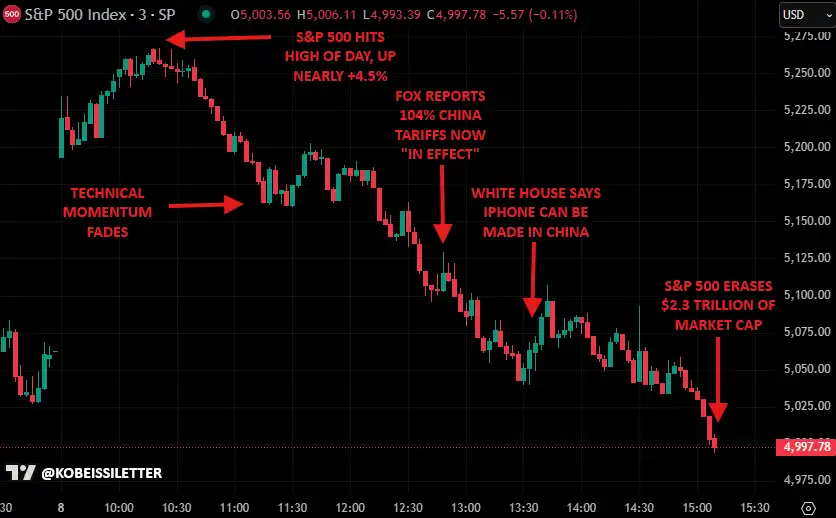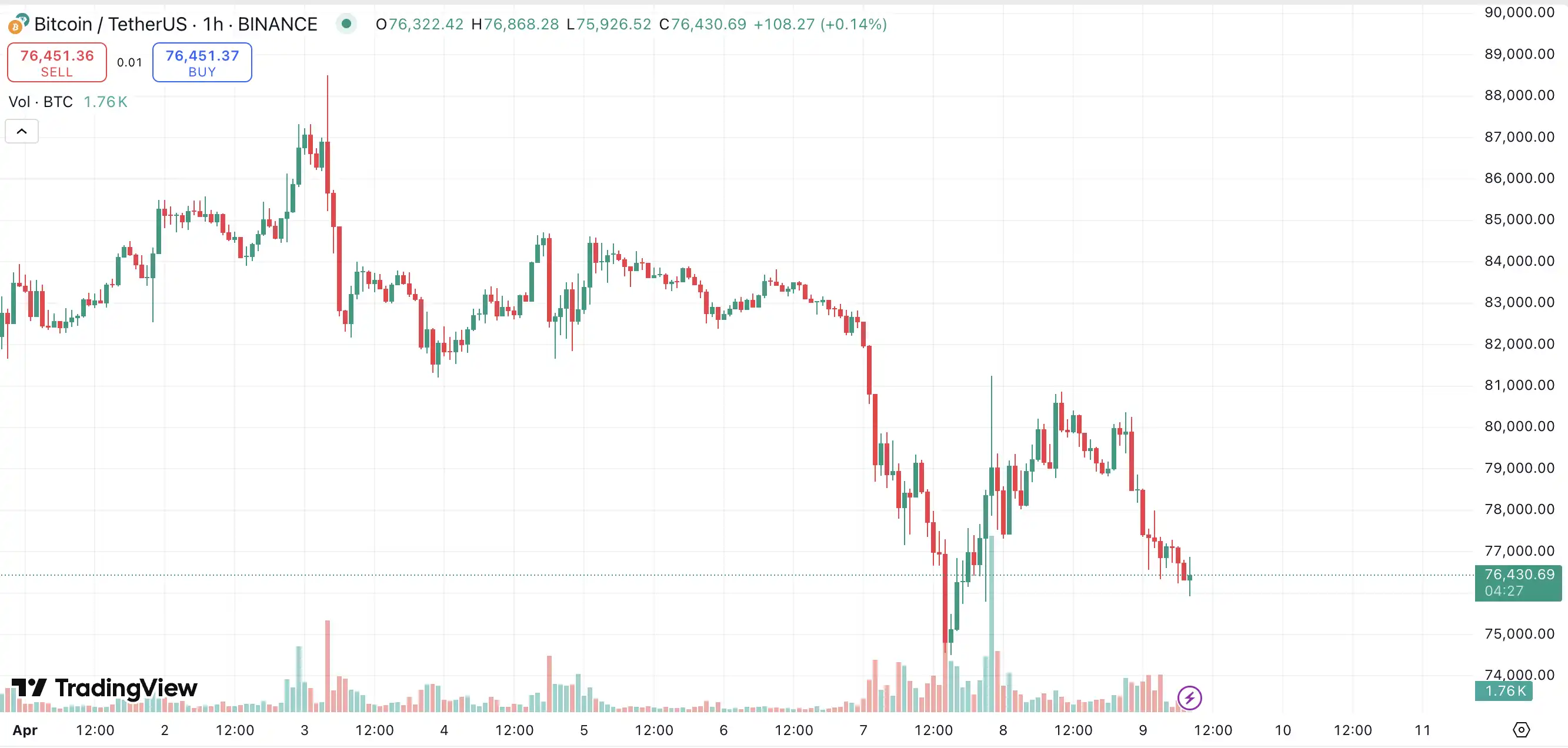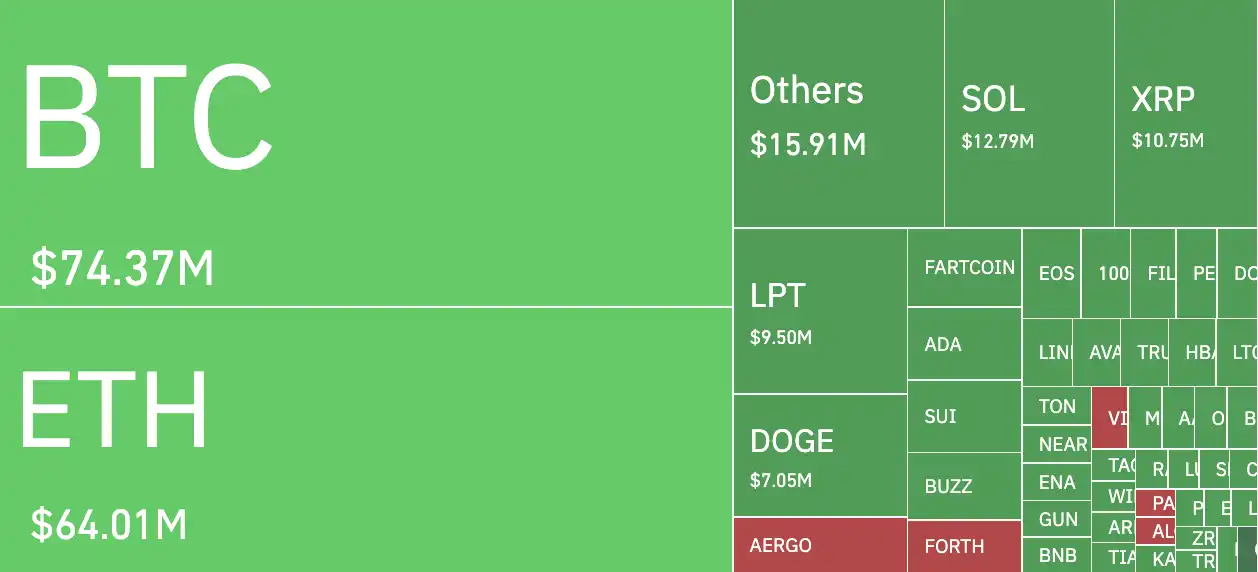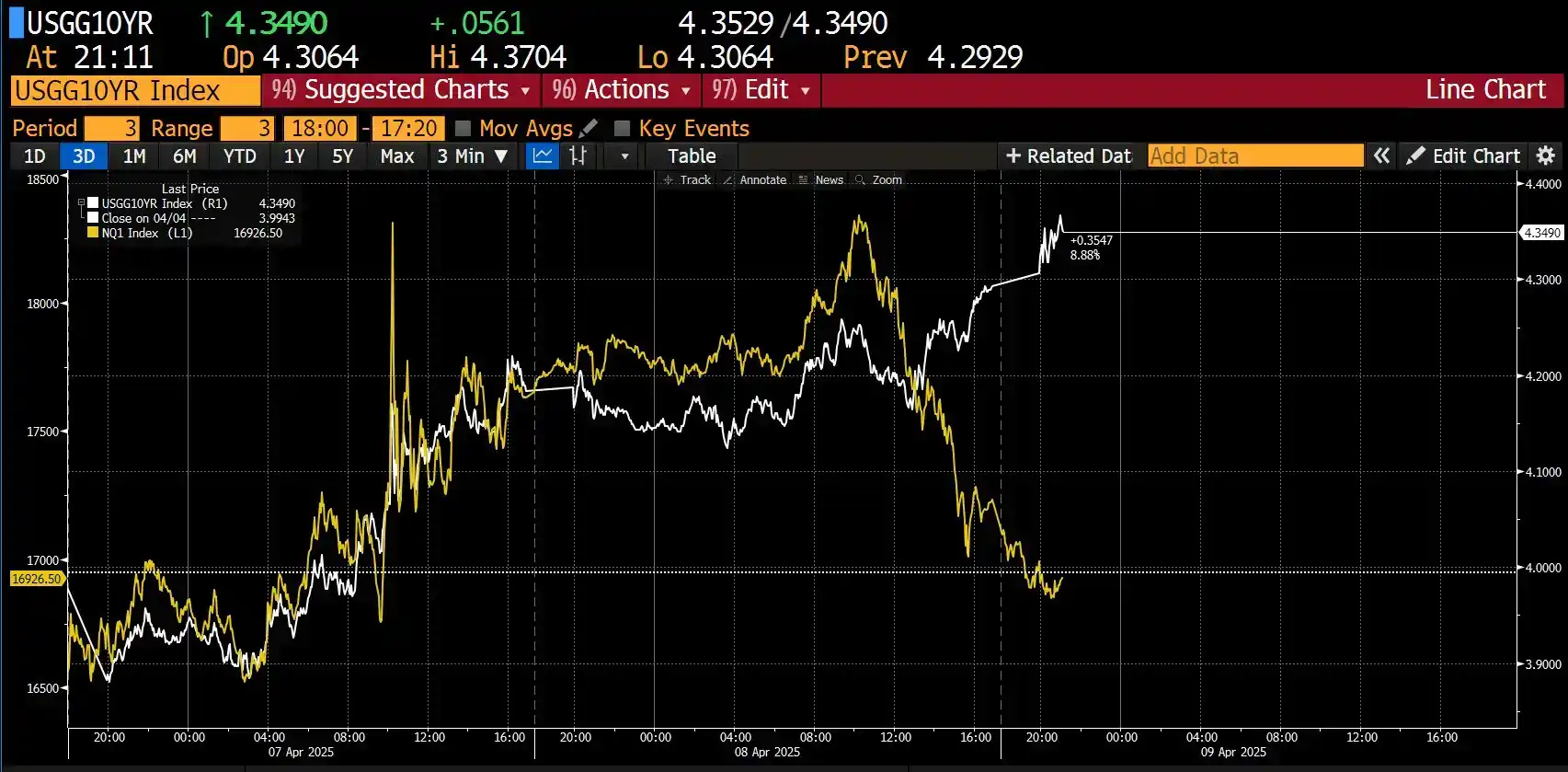The trade friction between China and the United States has escalated into an "economic nuclear war."
The bottom-fishing attempt has failed, and the market did not receive any good news. Early this morning, the White House press secretary announced that the additional 104% tariff on China took effect at noon Eastern Time, causing global financial markets to plunge again.
On April 3, when Trump's tariff policy was announced, U.S. Treasury Secretary Mnuchin suggested that all countries refrain from retaliatory actions and wait to see if any negotiations would occur before April 9. The "fake news" narrative was even revived, hoping for a rebound as Trump might be willing to negotiate on the trade barriers imposed on several countries and specific products, allowing global capital markets to briefly "come back to life."
However, after several days of negotiations, the market did not receive any good news. The tariffs increased from 10% at the beginning of the year to 20% in March, then to 34% in early April, and now an additional 50% "retaliatory increase" has turned the China-U.S. trade friction into an "economic nuclear war."
Can the stock market withstand another trade war between China and the U.S.?
Since the Trump administration announced a new round of tariff policies last week, international capital markets have experienced severe turbulence, with the U.S. stock market being the hardest hit. As of Tuesday's close, the S&P 500 index fell below 5,000 points for the first time in nearly a year, down 18.9% from its high on February 19, just a step away from the 20% decline threshold for a "technical bear market." It is estimated that the market capitalization of S&P 500 constituents evaporated by $5.8 trillion over four trading days, marking the worst four-day losing streak since the index was established in the 1950s.

Meanwhile, the U.S. tariff policy has triggered a chain reaction in global capital markets. According to Bloomberg, since Trump proposed the so-called "reciprocal tariffs" on April 3, the total market value of global stock markets has shrunk by $1 trillion, slightly more than half of the EU's GDP. U.S. tech giants have been hit hard, with the combined market value of seven major tech companies, including Apple and Microsoft, evaporating by $1.65 trillion. Apple, heavily reliant on overseas supply chains, saw its stock price plummet nearly 23% over four days, marking the largest weekly decline since the outbreak of the pandemic in 2020.
Previously, many opinion leaders in the crypto space firmly believed that the crypto asset class would not be affected by traditional tariffs, as their trading does not require crossing borders and customs. They argued that in the face of a new wave of mercantilism and trade barriers globally, the value proposition of cryptocurrencies would become even more pronounced. Strategy founder Michael Saylor stated on April 3, "Bitcoin has no tariffs."
However, the total market value of cryptocurrencies has fallen by 35% from its peak in December 2024, dropping from $3.9 trillion to $2.5 trillion. The "Crypto Fear and Greed Index" shows a reading of 17, indicating extreme fear in the market and a pessimistic sentiment.
Last night, Bitcoin fell below $75,000 again, while its market share continued to rise, and the altcoin market was in dire straits, with Ethereum dropping below $1,400 once more.

In the past 12 hours, the crypto market has seen a total liquidation of $243 million, with long positions liquidating $192 million and short positions liquidating $51 million.

The continuous decline in Bitcoin prices may even force Strategy, which has been buying aggressively, to sell its Bitcoin holdings. According to the 8-K form submitted by Strategy to the SEC on April 7, if Bitcoin prices continue to fall, Strategy may be forced to sell its Bitcoin holdings to repay debts, breaking Michael Saylor's promise of "never selling Bitcoin."
Since Trump won the election in November 2024, Strategy has purchased 275,965 BTC (worth $25.73 billion) at an average price of $93,228, and this portion has already incurred a loss of $4.6 billion.
Pessimistic expectations intensify, how do analysts view the current market?
In the past week, several Wall Street banks, including Goldman Sachs and JPMorgan Chase, have warned that if the trade war continues to escalate, the U.S. and even the global economy may fall into recession this year, further weakening the attractiveness of financial markets.
However, the White House team is celebrating victory, with Trump's chief trade advisor Peter Navarro stating on Fox News Monday night, "We are really bottoming out now. The next step will be a reversal, and those companies in the S&P 500 that are first to bring production back to the U.S. will drive the recovery, and it will happen soon. The Dow will hit 50,000 points, I guarantee it, and there will be no recession."
However, Navarro's optimistic remarks did not receive agreement from JPMorgan CEO Jamie Dimon, who warned in his annual letter to shareholders on Monday that Trump's tariffs would raise prices, drag down the global economy, and weaken the U.S.'s global standing by undermining its alliance system. Even some of Trump's allies, including Elon Musk and Bill Ackman, have recently warned that the logic behind this tariff policy is seriously flawed and represents a wrong path.
Crypto analyst Phyrex believes that based on the Federal Reserve's behavior, unless inflation significantly declines, even "defensive rate cuts" will be difficult to implement quickly. The real turning point may come when the U.S. GDP data is released at the end of April.
From the perspective of the crypto market, BTC's turnover rate has decreased today. URPD data shows that even if the price falls below $77,000, investors in the $93,000 to $98,000 range have hardly reduced their positions, indicating that the current selling pressure does not come from high-position holders, and there has been no panic selling at the top. The on-chain structure remains relatively healthy, and as long as subsequent policies do not fluctuate frequently, BTC and risk markets may still have room for phased recovery.
As U.S. Treasury bonds no longer play the role of a safe haven, the yield on 10-year Treasury bonds has risen to nearly 4.3%, higher than the level at the end of March, increasing the cost of mortgages and other types of loans. The yield on 30-year U.S. Treasury bonds closed at 4.76%, up nearly half a percentage point from Monday's low. The yield curve spread between U.S. two-year and ten-year Treasury bonds has widened to 48 basis points, the steepest level since May 2022.
BitMEX co-founder Arthur Hayes stated, "The Fed has little time left, and the situation is getting out of control. Previously, a stock market decline would lead to a drop in U.S. 10-year Treasury yields, benefiting risk assets. Now, the stock market is falling while U.S. 10-year Treasury yields are rising, which is bad news. The market has finally realized that if U.S. export revenues decrease, there will no longer be buyers for Treasury bonds or stocks, and the game is over."

Pessimistic expectations are still strengthening. Trader Eugene stated, "The introduction of global trade tariffs marks a change in the world order that has not been seen in over 50 years. Free trade has always been a key factor in driving productivity and economic growth, contributing to the largest long-term bull market in history. The shift from openness to protectionism will have profound effects, and these effects will take years to gradually manifest unless Trump completely abandons his tariff plans. I believe this possibility is very low. This will pose significant long-term resistance to global risk assets.
In terms of cryptocurrencies, the recent structural decline in active developers may be the most concerning issue. In the last cycle, we could observe developer activity and feel reassured, knowing that our industry still benefited from long-term tailwinds. Fast forward 2-3 years, and we have not produced anything particularly interesting or important, and the future outlook is even worse than it was then.
In the last cycle, we looked forward to the launch of ETFs and a better regulatory environment under supportive government leadership for cryptocurrencies as a glimmer of hope at the end of the tunnel. Now that these have been realized, they have (once again) failed to meet expectations, and I see no future developments that could free cryptocurrencies from their inherent "Ouroboros" (self-circling, self-consuming dilemma).
From a more macro perspective, the global situation is undergoing a significant transformation not seen in a century. Billionaire hedge fund manager and Bridgewater founder Ray Dalio stated that while the market and economic focus on tariffs is important, we should not overlook deeper global issues. He pointed out that we are in a "classic collapse" phase of monetary, political, and geopolitical order, a situation that may only occur once in a lifetime but has happened multiple times in history.
Dalio advises not to be distracted by short-term events like tariffs but to focus on the interactions of five major forces (economic, political, geopolitical, natural, and technological). Studying similar historical cycles (such as monetary crises) can help predict the future.
"The current changes are part of a historic long cycle; tariffs are just a surface phenomenon. The real driving factors are the structural collapse of monetary, political, and geopolitical order. Understanding the interactions of these forces and learning from historical experiences will better prepare us for the future."
免责声明:本文章仅代表作者个人观点,不代表本平台的立场和观点。本文章仅供信息分享,不构成对任何人的任何投资建议。用户与作者之间的任何争议,与本平台无关。如网页中刊载的文章或图片涉及侵权,请提供相关的权利证明和身份证明发送邮件到support@aicoin.com,本平台相关工作人员将会进行核查。




